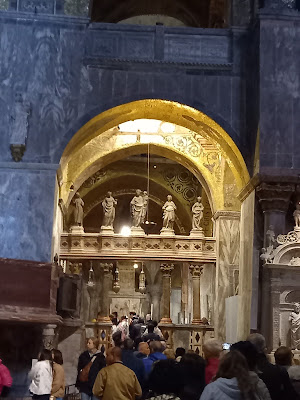Today’s adventure takes us to two of Venice’s outlying
islands, one of which I’ve heard of, and one of which I ain’t. Murano is world
famous for its glass. Burano is less world famous for its lace. The islands of
Curano, Durano, Furano etc. all sank during the Great Island Plague of 1844.
It was raining as we breakfasted, but appeared to slacken
off as we made the short walk to the jetty on the Grand Canal. Indeed, it
started to brighten up. We boarded our transport – larger than the water taxis
we arrived in, and were all able to get on the one boat – and headed across the
lagoon to Murano.
Murano is known for its glass, and our first stop was at a
glass-making factory. We watched the artists at work, including the new
apprentice, whilst our guide explained the history, the processes, and how the
art is now in decline – they have only eight glass blowers now. We then went
into the shop for the sales pitch, as he explained all about the properties and
uniqueness of each piece, and that we get 40% off for buying in the shop now. This
included gold- and platinum-plated glass sets, and also glasses that are
self-righting if you knock them over…a bit like Weebles. Nicola found a turtle
that she liked and after some negotiation we got it for a reasonable price.
 |
| Artist at work. Note the shirt |
We walked around the rest of the island, finding loads of
shops which all sell glass in all its different forms, but making no further
purchases. The weather remained inclement so by the time we were ready to embark
we boarded quickly, and set out to stop two.
Burano is the poor relation of Murano. We stopped for lunch
first, where we had risotto followed by mixed grilled fish (sole, monkfish, sea
bass and prawn), accompanied by – yes! – salad! Washed down with a Venetian
white wine. Afterwards we went walking around the town, which is notable for
its brightly-painted houses. The reason and origins of this custom aren’t
clear, but one thing is: if it wasn’t for this fact, the place would be a dump.
 |
| There was a fashion shoot going on when we were there |
We left Burano, and motored back to the Grand Canal. Our
mooring was at the far end so we had a bit of a walk to get back to the hotel,
during which we managed to get lost. Our map helpfully doesn’t have street
names, only the names of the largest landmarks and squares. We eventually found
our way, but only had a little bit of time before we were back out to
Teatro La Fenice for tonight’s opera.
Mefistofele is Arrigo Boito’s only completed opera. Who he?
Well, amongst other things, he was librettist to Verdi, who’s, like, famous as.
He wrote the words to Otello and Falstaff.
Mefistofele tells the story of Faust, but
from the viewpoint of the devil who had a bet with God (ain’t he a
charmer?), that he could tempt Faust to sell his soul. It appeared that
Mefistofele wasn’t ready to appear on stage, as the first thing he did was take
his clothes off and have a shower, whilst the orchestra played the prologue. That’s
opera for you! The later stages were also prepared and choreographed very well,
particularly the witches sabbath. There appeared to be a cast of thousands –
indeed, when it came to the curtain call, I’m sure the cast outnumbered the
audience, as there were various choruses of children, angels, witches, and, er, other
unspecified folk; a ballet troupe; and all the main characters.
It was all jolly entertaining, and the cast kept coming back
for more curtain calls. This, it transpired, was because it was in fact the
last performance.



































